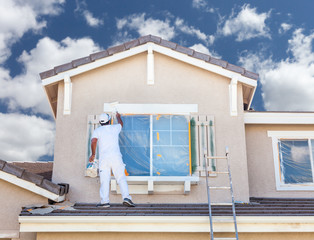House painting is one of the most powerful and affordable ways to transform a home. A fresh coat of paint can refresh tired walls, highlight architectural details, and instantly boost curb appeal. Whether you’re updating interiors, exteriors, or just an accent wall, a thoughtful approach to color and technique can completely change how a space looks and feels.

Understanding the Power of Color
Color sets the tone for any room. Warm tones like soft yellows, rich terracottas, or muted oranges create a cozy and inviting atmosphere, while cool shades such as blues and greens promote calmness and relaxation. Neutrals like beige, cream, and gray remain timeless and versatile, making them ideal for living rooms, hallways, or spaces you might redecorate frequently.
Before selecting your palette, consider the mood you want to evoke. Bright and bold shades can energize a space, while subtle pastels can make it feel airy and light. Testing paint swatches on a small section of wall helps you see how colors look at different times of the day under varying lighting conditions.
Preparing Your Surfaces for Success
Good preparation is crucial for a professional-looking finish. Start by cleaning walls to remove dust, grease, or mildew, especially in kitchens and bathrooms. Fill any cracks or holes with appropriate filler and sand them smooth once dry. This ensures the paint adheres evenly and hides imperfections.
If you’re covering a darker color with a lighter one, applying a primer first can save time and coats of paint. Primer also improves durability and provides a more uniform base for your chosen color.
Choosing the Right Finish
Paint isn’t just about color—it’s also about finish. Matte and flat finishes offer a smooth, non-reflective surface that hides minor imperfections, making them ideal for ceilings and low-traffic areas. Eggshell and satin finishes add a subtle sheen and are easier to clean, which works well in living rooms, hallways, and children’s rooms.
For kitchens, bathrooms, or other high-moisture areas, consider semi-gloss or gloss finishes. These reflect more light, stand up to scrubbing, and resist moisture better. Using the right finish ensures longevity and keeps your walls looking fresh for years.
Mastering Techniques for a Professional Look
Even with good paint and brushes, technique matters. Start by cutting in along edges, corners, and trim with a high-quality angled brush. This creates clean lines and prevents roller marks from reaching areas where precision is needed.
When rolling paint onto larger sections, use a “W” pattern to distribute it evenly. Work in small sections and keep a wet edge to avoid streaks or visible lines. Apply multiple thin coats rather than one thick coat for a smoother, more even finish.
Considering Accent Walls and Creative Touches
If you’re hesitant about bold colors, try using them on a single accent wall. This approach adds personality without overwhelming the space. You can also experiment with stripes, color blocking, or stenciled designs to bring visual interest.
Adding painted trim, wainscoting, or even ceilings in a contrasting color can create depth and sophistication. Small touches like painting door frames, window sills, or built-in shelves in complementary shades can subtly elevate the overall look.
Exterior Painting for Curb Appeal
Exterior painting not only boosts your home’s appearance but also protects it from the elements. When choosing exterior colors, consider your home’s architecture and surroundings. Lighter shades can make a small house appear larger, while darker tones provide dramatic contrast and hide dirt more effectively.
Preparation is just as important outside as inside. Power washing, scraping off peeling paint, and repairing any damaged siding or trim will help your exterior paint last longer. Choose weather-resistant finishes specifically designed for outdoor conditions to withstand sun, rain, and temperature changes.
Safety and Practical Considerations
House painting often involves ladders, solvents, and ventilation. Always ensure proper airflow when painting indoors, especially with stronger formulations. Wear protective clothing, gloves, and masks when needed. Secure ladders on stable ground and never overreach.
If you’re painting ceilings or high walls, using extension poles for rollers can reduce strain and improve coverage. Taking these precautions makes the process safer and more efficient.
Saving Time with Planning
Planning can save hours of frustration. Gather all your supplies before you begin: brushes, rollers, trays, painter’s tape, drop cloths, and cleaning materials. Move or cover furniture and tape off trim, outlets, and other features you don’t want painted.
Working systematically—starting from the top down—helps prevent drips and touch-ups later. Paint ceilings first, then walls, and finally trim. This sequence minimizes the need for corrections and keeps your lines crisp.
Maintaining Painted Surfaces
Once your new paint job is complete, a little care goes a long way. Regularly dust or gently wash walls to keep them looking fresh. Touch up small scuffs or chips promptly to maintain a uniform appearance. For exterior surfaces, periodic inspections can alert you to peeling or cracking early, allowing for easy maintenance rather than full repaints.
Bringing It All Together
House painting is both a practical improvement and a creative outlet. By choosing the right colors, finishes, and techniques, you can dramatically change the look and feel of your home inside and out. Proper preparation and maintenance ensure your hard work lasts, protecting your investment and keeping your spaces beautiful.
Whether you tackle the job yourself or hire professionals, painting offers one of the most effective ways to refresh a home. From a single accent wall to a full exterior makeover, the possibilities are endless. With patience, planning, and a touch of creativity, you can transform your living space into something vibrant, welcoming, and uniquely yours.